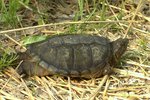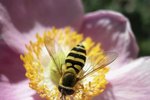
Painted turtles are easily identified by colorful markings on their heads, necks and shells. The most widely distributed turtles in North America, they're found in freshwater ponds, lakes, rivers and streams throughout the continent. There are four subspecies of painted turtles: eastern, midland, southern and western. Their ranges overlap, and they can interbreed. Interbred offspring are called intergrades.
Mating Habits
Painted turtles breed from March to mid-June. The male faces the female and waves his front claws at her, sometimes caressing the sides of her neck. The female leaves the water to make her nest between May and July. She may travel a few yards or a half-mile to find a suitable nesting site, often crossing fences, roads and yards. She digs a hole about six inches deep and deposits up to 11 eggs.
Incubation
The female painted turtle covers the eggs with dirt and returns to the water, her job done. The eggs hatch in 72 days, usually in late August through early September. The baby turtles instinctively head straight for the water. Late hatchers may stay in the nest until spring. The sex of the hatchlings is determined by nest temperature. Young turtles will be males if temperatures are cool, females if temperatures are warm.
Predators
Nests are often discovered by birds, racoons and skunks, who make a meal of the eggs. Newly hatched turtles, about the size of a quarter, are easy prey for birds, foxes, raccoons, skunks, snakes and large fish. It's not unusual for 90 percent of painted turtle eggs and babies to be lost to predators. Predators don't normally bother adult turtles, but it's possible for them to lose limbs if they're attacked by predators on land.
Hatchling to Adult
As the young turtle grows he sheds the outer layer of bony plates on his shell, growing larger plates underneath. Males reach maturity when they're 2 to 5 years old; females are mature at 4 to 8 years old. Males are smaller than females, with longer, thicker tails and longer front claws. Painted turtles live 20 to 40 years.
Adult Lifestyle
Painted turtles live and eat underwater. They feed on aquatic insects, plants, small mollusks, carrion, crayfish, tadpoles and fish. Painted turtles have the ability to breathe air or extract oxygen from the water, and they sleep underwater, burrowing under the mud and sand. During winters they hibernate buried in mud, emerging in March to begin their breeding cycle.
References
Photo Credits
-
Jupiterimages/Photos.com/Getty Images
Writer Bio
Karen Mihaylo has been a writer since 2009. She has been a professional dog groomer since 1982 and is certified in canine massage therapy. Mihaylo holds an associate degree in human services from Delaware Technical and Community College.




